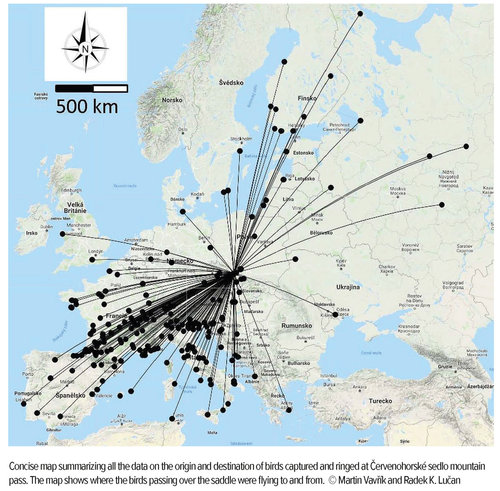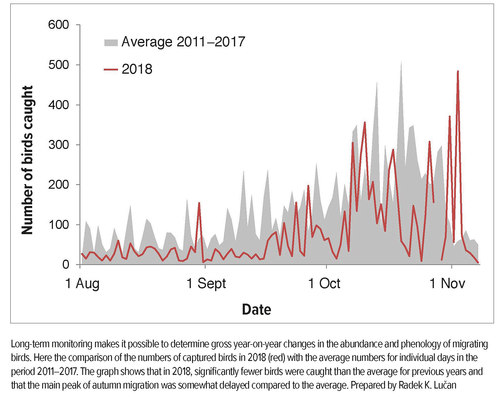Nature Conservation 2020 — 25. 3. 2020 — Research, Surveys and Data Management — Print article in pdf
Červenohorské sedlo mountain pass:
the History and Present of Watching (not only) Bird Migration in our Mountains

The west-east oriented main ridge of the Jeseníky Mountains is an important migration barrier for flying animals. The remarkable col of the Červenohorské sedlo mountain pass, visible from afar, allows them to cross this barrier with less effort than if they flew over the Jeseníky ridges, and it is no wonder that especially during the autumn migration a huge number of birds, bats and various groups of migratory insects are funnelled into the relatively narrow corridor of the saddle. Since 2010, this site has been used for monitoring of migratory birds, to which the monitoring of the passage of bats and selected groups of migratory insects has been added in recent years. Especially in connection with bird migration, this is currently the largest research project in the Czech Republic and is the only locality where birds can be observed under appropriate conditions during both daytime and night-time migrations.
Brief history
But let’s go back a few decades to the beginnings of the study of bird migration in mountain areas in our geographical space. The observation of intensive daytime bird migrations in the Alpine passes, formerly mainly associated with trapping birds for food, led in 1958 to the establishment of a research base in the Swiss Col de Bretolet mountain pass, where regular monitoring, including catching and ringing migratory birds, is performed. Every autumn, around 20,000 birds are ringed on average and night-time catches have gradually been added to the daily catches. In the early 1970s, the large concentration of migrating birds during the autumn migration in the western Krkonoše Mountains, in the area between the peak of Tvarožník and the Trzi Świńki massif, was noticed by a Polish team of ornithologists headed by Prof. Andrzej Dyrcz of Wrocław University, who studied this phenomenon for several years. Gradually, in addition to visual observations, birds were also caught and ringed. During 3 seasons (1971–1973), nearly 4,000 birds were captured and over 130,000 individuals of 91 bird species were visually recorded. The results also showed the first laws on the nature of migration, its phenology and, thanks to the later observations of ringed birds, also about the origin or destination of some migrating species.
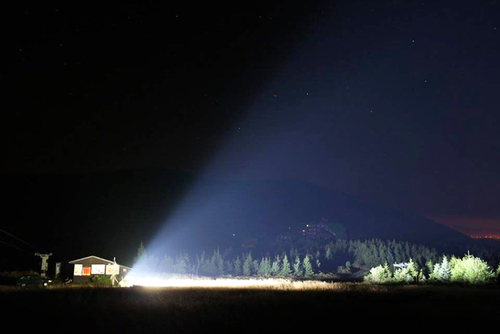
With the use of a strong light source in combination with appropriately
placed capture nets and voice reproduction, bird migration over
Červenohorské sedlo mountain pass is monitored like a live broadcast.
Photo by Martin Vavřík
Who discovered light?
The breakthrough in monitoring bird migration in the mountains came with the discovery of the possibility of observing birds at night using a strong light source. In the early 1980s, inspired by anecdotal reports of watching mass night-time arrivals of birds to lighthouses or ship lights on the seas of northern and western Europe, Czech ornithologists began a series of experiments in the Krkonoše Mountains and later in the Orlické Mountains using this possibility to observe bird migration under the so-called Baltic Action, which was the first coordinated programme to monitor bird migration in central, northern and eastern Europe. Gradually, it was shown that by means of a strong light source, especially during nights with reduced visibility, migrating birds are not only attracted to the vicinity of the light source, but when appropriately positioned capturing devices, most often traditional ornithological nets, are used; they can also be captured for ringing.
It is interesting to note that this method was discovered and used independently in at least two other, geographically very distant places on our planet. Since 1969 in Kenya, Africa, a large number (about 500,000 birds in 1969–2012) of mostly Palearctic migrants have been regularly captured and individually tagged on foggy nights in November and December at the Ngulia Lodge in Tsavo NP. At the other end of the world, at Dalton Pass on the Philippine island of Luzon, since time immemorial the natives have used fires lit in cave entrances to catch migrating birds. This inspired British ornithologists around 2010, who subsequently managed to prove the existence of the migration routes of a number of very rare bird species. For example, most of the known individuals of the reed warbler Acrocephalus sorgophilus have been captured here, although its breeding sites are still unknown and it is probably at the brink of extinction.
Krkonoše and Orlické Mountains Phase of Research
In the beginnings of the systematic monitoring of night-time migration, which took place mainly at Šerlich in the Orlické Mountains in the 1980s (M. Hromádko, K. Čihák and others) and in the 1990s in the eastern Giant Mountains at Rýchory (P. Miles and others), in the course of autumn migration only a few thousand birds were captured, but the results were also ground-breaking, as many unexpected species such as reed warblers, grasshopper-warblers, flycatchers, nightingales or wheatears were caught as they flew over the mountains. In many cases these were extreme phenological records from a time when the passage of these species was no longer expected. A significant quantitative shift occurred in the late 1990s, when a group of Prague ornithologists (F. Zicha, L. Červa, J. Jelínek, L. Hovorka, J. Rosmus and others) focused on night-time capture in the area of Vosecká bouda in the western Krkonoše Mountains, that is, to a place with the previously known mass daytime migration. BBy optimizing the combination of the light source used with suitably positioned mist-nets and playback of bird voices, in 1999–2008 nearly 40,000 individuals of 87 bird species were captured and ringed. These captures have already provided a relatively good idea of the composition and phenology of the daytime and night-time migrating bird communities, a lot of interesting information about the origin and destination of the migrating birds and last but not least, records of very rare species which have only been found in our country very sporadically.
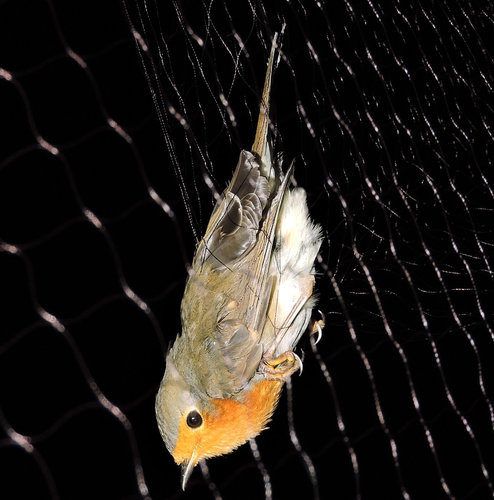
The European robin (Erithacus rubecula) is the most frequent species
recorded during the nocturnal migration at the Červenohorské sedlo mountain pass.
In total, over 34,000 birds were ringed in 2010–2018. Photo Radek K. Lučan
Jeseníky Mountains
After the research in the Krkonoše Mountains was completed, based on previous systematic visual observation of mass daytime migrations, but also several attempts at night-time captures in the mid-1990s (L. Doupal, T. Pospíšil, L. Hajný), Červenohorské sedlo mountain pass in the Jeseníky Mountains appeared to be another suitable, comparative locality. The very first experimental season in 2010 aimed at verifying the suitability of the site and methodological optimization confirmed the correctness of this assumption, as during 30 days of the autumn migration, more than 5000 birds of nearly 70 species were captured and ringed, about half of them during the night. Until 2014, the bird capture and ringing event was carried out between August and November intermittently in the range of 60–70 days and nights of capture, according to the time availability of several ringers. Since 2015, thanks to the cooperation with the Department of Zoology, Faculty of Sciences, Charles University in Prague, we managed to cover the whole season from mid-August to early November for the first time. Since 2016, monitoring has been running continuously for 3 months from early August to early November. Thanks to this, we have managed to cover the migration period of species, the migration of which peaks at the turn of July and August, such as the nightingale, Eurasian river warbler or marsh warbler.
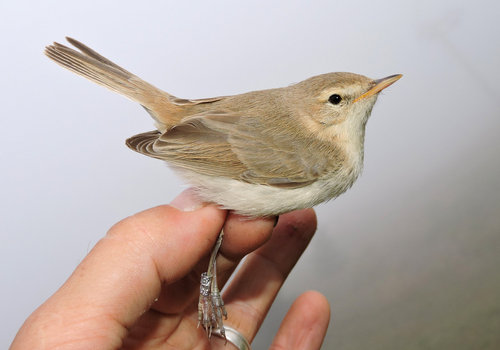
The booted warbler (Iduna caligata) in the Czech Republic is only a very rare
vagrant. Both of its previous records come from Červenohorské sedlo
mountain pass. Photo Radek K. Lučan
During the years 2010–2018, almost 100,000 birds of 125 species were caught and ringed at Červenohorské sedlo mountain pass, about half of them during their night-time migration. Such a large amount of data already allows us to postulate a number of partial conclusions, and the heuristic potential of the whole research further increases with the length of the time series. At least since the methodological standardization in 2015, the project has had the character of monitoring; besides the changes in the abundance, structure and phenology of migrating communities, basic biometric data and data on the fitness of migrating birds are also collected. Of course meteorological data is collected as well, because the current state of the weather is directly reflected not only in the intensity of migration, but also in the success of catching at least certain bird species. In addition to the captures themselves, the abundance of migrating birds is monitored visually, as the trapping does not always reflect the abundance of migrating birds, particularly under specific climatic conditions and for certain groups of species. The observable daytime migration here is particularly spectacular, especially in October, when many tens of thousands of birds, especially finches, often fly over during a single morning. High quality data has been collected on low-flying migratory species that fly through the vegetation and respond well to attraction via the voice recordings (e.g. goldcrest, dunnock, wren, tits), whereas most species of daytime migrants flying through open space at higher altitudes are significantly underrepresented. This is illustrated, for example, by the common chaffinch, which represents over 50% of the daytime migrating birds, but only makes up about 3% of the sample from the daily captures. On the contrary, the most frequently caught nocturnal migrant, the European robin (roughly half of all birds ringed here), is very likely to approach the real relative abundance of this species among night-time migrants, which also correlates with data from other bird monitoring localities in Europe.
Rarities and icons
In addition to species that can commonly be recorded elsewhere during migration, at Červenohorské sedlo mountain pass we also regularly record species of a very rare or hardly detectable nature, mainly due to nocturnal capture. The first type includes several rare species straying from areas far to the north or east of our country, such as the dusky warbler (Phylloscopus fuscatus, 1st record for Czechia), Radde’s warbler (Phylloscopus schwarzii, 2nd record for Czechia), Pallas’s warbler (Phylloscopus proregulus, 3 of 9 records for Czechia), yellow-browed warbler, half of all records for Czechia!), booted warbler (Iduna caligata, first two records for Czechia), pine bunting (Emberiza leucocephala, 3rd record for Czechia) and Siberian accentor (Prunella montanella, 2nd record for Czechia). The second group includes, for example, the emblem species of Červenohorské sedlo mountain pass, the woodcock (Scolopax rusticola), of which over 600 have been ringed so far, which is the vast majority of all woodcocks that have ever been ringed in Czechia. Numerous data from the retrospective finds of the ringed woodcock here show, among other things, what great hunting pressure this species is exposed to in its wintering grounds in southern and western Europe.
Further aspects of bird migration
The data on changes in the intensity of migration, which does not occur all the time with the same intensity but is concentrated in significant migration waves, when after a longer quiet period there are certain days when mass migration of most species typical of the period takes place, and after that again followed by several days to weeks of relative lack of activity. Studying the causes of these fluctuations will certainly yield a number of interesting findings, although many factors have recently been well studied in other regions of the world through the development of the use of radar tracking. Knowledge of the phenology of migration of foreign populations across our territory is also very valuable, as observation in other areas (typically in the lowlands) often does not distinguish members of our populations from members of populations from outside our country. Moreover, in many species the autumn passage is very inconspicuous. This applies for example to the nightjar, nightingale, grasshopper warblers, goldcrests, flycatchers, but also the tits and chaffinches. Equally interesting are cross-species comparisons of circadian migration activity data, where many species migrate exclusively either at different times of the day or at night. However, in many species, during the season, there is a shift in migration activity from day to night or vice versa.
Migration of bats and selected groups of insects
Based on the netting activity, the site has proven to be important for another group of flying vertebrates, bats. Since 2015, monitoring of the flight activity of bats, using automatic flight activity recorders (so-called ‘batcorders’), has been added to the monitoring of bird migration, because even among bats there are more species of long-distance migrants and many others that carry out shorter-distance seasonal movements. In total, at least 21 bat species were detected by a combination of captures and echolocation records at Červenohorské sedlo mountain pass, including the largest European bat, the greater noctule (Nyctalus lasiopterus), the regular presence of which indicates the possibility of its permanent population in a wider area.
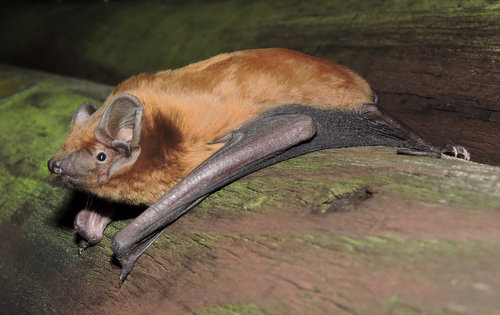
The common noctule (Nyctalus noctula) is a typical example of a long-distance
migrant which migrates over Červenohorské sedlo mountain pass in huge
numbers, especially in late September and in October. Photo Radek K. Lučan
In order to complement the spectrum of flying migrants with invertebrates, since the autumn migration of 2015, selected groups of migratory moths (some hawk-moths and others), which are also known for their long-range seasonal flights, have been regularly recorded at the locality. As a result, the migration of the convolvulus hawk-moth is regularly recorded in large quantities here every year, and the migrations of the very rare death’s-head hawk-moth are regularly detected in our country. For example, in 2016 the flight of the Mediterranean striped hawk-moth was recorded. In 2018, monitoring of the daytime migration of hoverflies was also started, which is a very striking phenomenon in the autumn period, but so far described only very inadequately. The preliminary results are very promising.
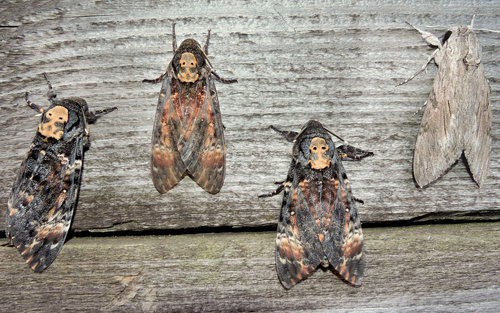
Death’s-head hawk-moth (Acherontia atropos) and convolvulus hawk-moth
(Agrius convolvuli) – typical night moth representatives of long-distance migrants;
their autumn passage over Červenohorské sedlo mountain pass is regularly monitored.
Photo Radek K. Lučan
The whole project is professionally backed by the Department of Zoology, Faculty of Sciences, Charles University in Prague and takes place on a platform of cooperation between the Jeseníky PLA Administration, NCA CR, Ringing Station of the National Museum in Prague, Forests of the Czech Republic and Červenohorské sedlo Ski Area and would not be possible without large numbers of volunteering collaborators such as bird ringers, students and educators at several of our universities and many other interested parties, as well as volunteering contributors, who have played very significant roles in the course of the research. The current activities and results of the project can also be found on the website www.fkcso.cz/chs


